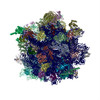+Search query
-Structure paper
| Title | Promiscuous behaviour of archaeal ribosomal proteins: implications for eukaryotic ribosome evolution. |
|---|---|
| Journal, issue, pages | Nucleic Acids Res, Vol. 41, Issue 2, Page 1284-1293, Year 2013 |
| Publish date | Dec 6, 2012 |
 Authors Authors | Jean-Paul Armache / Andreas M Anger / Viter Márquez / Sibylle Franckenberg / Thomas Fröhlich / Elizabeth Villa / Otto Berninghausen / Michael Thomm / Georg J Arnold / Roland Beckmann / Daniel N Wilson /  |
| PubMed Abstract | In all living cells, protein synthesis occurs on ribonucleoprotein particles called ribosomes. Molecular models have been reported for complete bacterial 70S and eukaryotic 80S ribosomes; however, ...In all living cells, protein synthesis occurs on ribonucleoprotein particles called ribosomes. Molecular models have been reported for complete bacterial 70S and eukaryotic 80S ribosomes; however, only molecular models of large 50S subunits have been reported for archaea. Here, we present a complete molecular model for the Pyrococcus furiosus 70S ribosome based on a 6.6 Å cryo-electron microscopy map. Moreover, we have determined cryo-electron microscopy reconstructions of the Euryarchaeota Methanococcus igneus and Thermococcus kodakaraensis 70S ribosomes and Crenarchaeota Staphylothermus marinus 50S subunit. Examination of these structures reveals a surprising promiscuous behavior of archaeal ribosomal proteins: We observe intersubunit promiscuity of S24e and L8e (L7ae), the latter binding to the head of the small subunit, analogous to S12e in eukaryotes. Moreover, L8e and L14e exhibit intrasubunit promiscuity, being present in two copies per archaeal 50S subunit, with the additional binding site of L14e analogous to the related eukaryotic r-protein L27e. Collectively, these findings suggest insights into the evolution of eukaryotic ribosomal proteins through increased copy number and binding site promiscuity. |
 External links External links |  Nucleic Acids Res / Nucleic Acids Res /  PubMed:23222135 / PubMed:23222135 /  PubMed Central PubMed Central |
| Methods | EM (single particle) |
| Resolution | 6.6 - 24.0 Å |
| Structure data |  EMDB-2170:  EMDB-2171:  EMDB-2172:  PDB-4v6u: |
| Source |
|
 Keywords Keywords |  RIBOSOME / RIBOSOME /  archaea / archaea /  archaeal / archaeal /  ribosomal / 70S / kink-turn / ribosomal / 70S / kink-turn /  protein synthesis / protein synthesis /  RNA RNA |
 Movie
Movie Controller
Controller Structure viewers
Structure viewers About Yorodumi Papers
About Yorodumi Papers





